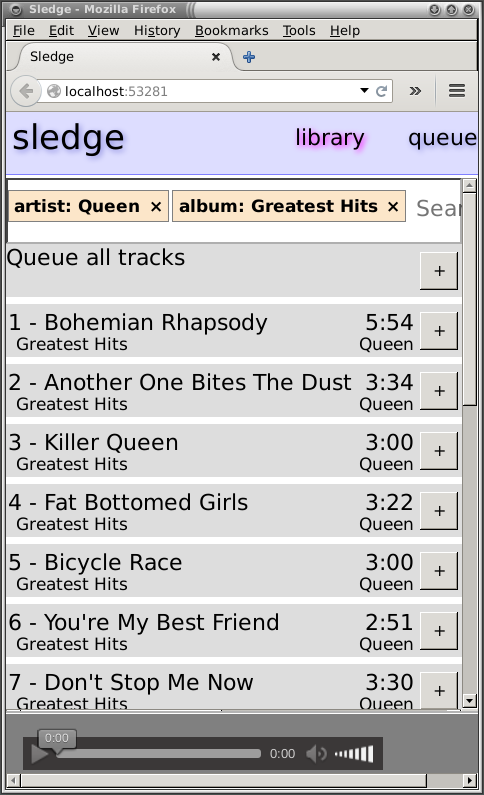Lucene, you don't do your Daddy's will#
Thu, 22 Jan 2015 07:10:54 +0000

I'm only showing you pictures of the new Sledge UI as a stopgap, as
it will shortly be replaced with the new new Sledge UI.
I Am Keeping: the way we allow search refining. Each search you
request (either by typing something in or by clicking an artist or
title name) is turned into one of those little yellow label things and
then you can remove it again just by clicking the 'x' (I stole this
idiom from the amazon ec2 console ui, but it's also what the gmail
composer does when you type addresses into the to/from lines).
I Am Losing: the link to 'view play queue'. Rather than a 'tabs'
metaphor, we will have an 'expand' button in the player area at the
bottom which causes the queue to roll up and overlay the search
results.
Also To Go: the browser-native audio controls, which are getting
replaced with something that is consistent across browsers.
But the bigger reason for writing: already gone, the Lucene interface
for storing the music database. I started working on having Sledge
monitor its music folders for additions/deletions, and realised just
how hard it is to persuade Lucene to search for an exact match on a
particular field with no ambiguity or helpful tokenising - which is
necessary when you want to delete the record for a file that's not in
the filesytsem any more. So now we're using a flat file and EDN and
doing our own tokenising into a bunch of maps that are created at load
time. It's actually faster too, but I don't think that's anything to
do with Lucene, more with it being the second stab at the problem.
This has now taken substantially more than one weekend and it's still
not done. Damn scope creep.
The Invisible AUDIO element#
Thu, 22 Jan 2015 19:26:47 +0000
I said this morning that I was going to replace the browser-native
audio controls with something which looks (approximately, at least)
consistent everywhere. There's another couple of reasons for wanting
to revisit the way we render the audio element
- on the default Android browser, we don't get an
ended event when
the player gets to the end of the track, which means every five
minutes I have to pick the phone up and unlock it and press 'remove'
in the play queue to trigger the next track
- when the screen is sleeping or the tab is hidden, the
requestAnimationFrame handler that triggers Om repaints is called
late or not at all. Again, time to pick the phone up and unlock and ...
- I want/need to make it run on Windows, which does not support Ogg in
the
audio element. Although in principle I could hang multiple
source children onto the audio element and let the browser choose
which one it likes best, rewriting the DOM after it has been parsed
is said to be not a good
idea which means using info from the JS canPlayType method to choose the bext format for each track from those available for that track.
The nice thing about Om application state is that it's also a
perfectly ordinary Clojure atom and we can call add-watch on it to
have a perfectly ordinary Clojure(Script) function called whenever it
changes. So what we're going to do is
- a new key in
app-state to contain the desired player state
- an Om component to render a player UI, and update this desired state
when buttons are clicked
- some event handlers to get news from the audio element and figure
out what it might be doing (principally, has it reached the end of
the track, or is it having connectivity issues) and update the
desired state correspondingly
- a watch on app-state that calls the function currently named
sync-player-state, which compares the desired state to what the
audio element is actually doing, and updates the audio element
appropriately
